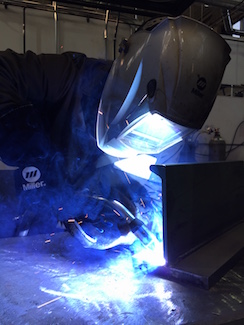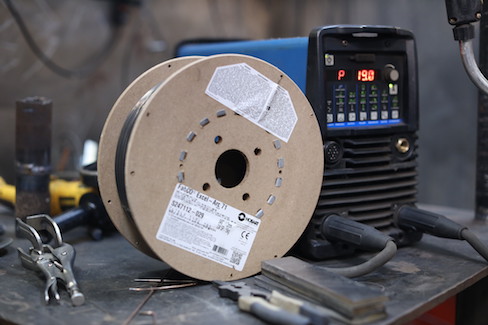Improving Weld Quality in Production Environments
Addressing poor weld quality, failures, and rework takes longer and costs more to resolve as a part moves through the welding process. Follow these seven rules of thumb to enhance your operation’s throughput.
Posted: September 24, 2020
MELTING POINT COLUMN
BY CALEB HAVEN
For companies struggling to find and retain skilled welders, weld quality in their production environment — whether it’s a manufacturing or fabrication shop — can often suffer. Unfortunately, the problem stands to worsen with the U.S. facing an anticipated welder shortage of 400,000 by 2024.
The issue is also compounded by the fact that customer demands for high quality and the cost of weld failures hasn’t changed. In some cases, it’s even increased.
So how can companies improve weld quality under these circumstances?
It comes down to planning, training, and an ongoing assessment of the welding operation.
Establish Forgiving Welding Procedures
The time and cost of addressing poor weld quality, failures, and rework increases incrementally the further a part moves through the welding operation. For that reason, it’s important to establish forgiving welding procedures. These can offer some flexibility to welders who are still building their skill set and make it easier to achieve high weld quality in the first place.
There are several ways to approach a welding procedure — a document that offers direction for completing welds accurately — to help eliminate some of the barriers to creating quality welds. Keep in mind that certain applications require welding operations to follow standards set forth by American Welding Society (AWS) codes, and some may be more stringent than others.
A good starting point is to make test welds to determine how to maintain a specific weld size or penetration profile and to test welds on different material conditions. These tests will provide information to incorporate into the weld procedure, so welders know the parameters necessary to obtain the desired outcome.
Other options to consider for a welding procedure include:
Filler metals that allow for variation in skill level. These include metal-cored welding wires, which generate a wider penetration profile, flatter weld bead, and a greater tolerance for dirty or coated material. They are similar in operation to solid wires (e.g., gun angle and operator technique) and relatively easy to learn to use.
Gas-shielded flux-cored wires are another option, particularly to simplify vertical and overhead welding, as well as gain good weld penetration and flat bead appearance.
Welding processes that support high weld quality. Pulsed MIG welding offers synergic settings that adjust the voltage or the power to the arc automatically when the wire feed speed changes. This adjustment makes it easier for the welder to produce a quality weld since it doesn’t require manually setting the machine, which could lead to incorrect parameters.
Similarly, a regulated metal deposit (RMD) or modified short circuit process is beneficial, particularly for welders of varying skill sets. This process maintains a consistent arc length even if a welder’s welding wire stickout changes, so weld quality is also consistent. It also allows a good view of the weld pool, which enables greater welder control, and is a very- low-heat-input process that works well for bridging gaps on thinner materials without the risk of burn-through.
In addition to supporting good weld quality, a flexible welding procedure with these components can simplify training.
Design For Weldability
As with establishing a welding procedure that helps welders succeed, designing parts with weldability in mind is important. Joints that can be easily accessed prevent the welder from having to maneuver awkwardly, which could hinder weld pool control and adversely affect weld quality. When possible, design parts that can be welded in the flat and horizontal positions. These positions are more comfortable for the welder and again afford more control.
Additionally, a weld joint design that manages gaps and prevents poor fit-up is ideal. Be certain that stamping and forming of parts upstream is consistent, so when the parts enter the welding cell they are in the best condition possible to be welded accurately. This is particularly important the more complex the parts are. Repeatability is key.
Sustaining Quality
Placing lock and limits on welding equipment is a good way to maintain weld quality among welders. Many power sources allow welding supervisors to set parameters according to the welding procedure, voltage and wire feed speed being among the main settings. These can be locked in within a range of +/- 10%, for example. That gives welders a window of freedom to adjust the process slightly to their preference without compromising welding parameters or quality.
Providing work instructions is another way to sustain weld quality, especially with more complex assemblies with multiple parts. Giving welders direction on fixturing, tacking, and welding — including the sequence of welds, staggering welds, and weld length — can minimize gaps, poor fit-up or distortion that requires rework later. These instructions can be posted on a clipboard or folder in the weld cell. There is also production monitoring software and equipment that can help companies manage work instructions via a computer screen in the weld cell.
Periodic Reviews
For a company to maintain high levels of weld quality, it’s critical to monitor the
operation carefully and consistently. Periodically review welding procedures and parameters, as well as general manufacturing and fabrication processes, to confirm they’re still yielding the proper results. Should any weld failures occur, conduct a thorough assessment to identify the source of the problem so it can be rectified.
Training for new welders and ongoing refreshers for more experienced welders are also a good idea. These continuous improvement efforts take time and resources, but are well worth it in the long term.

















